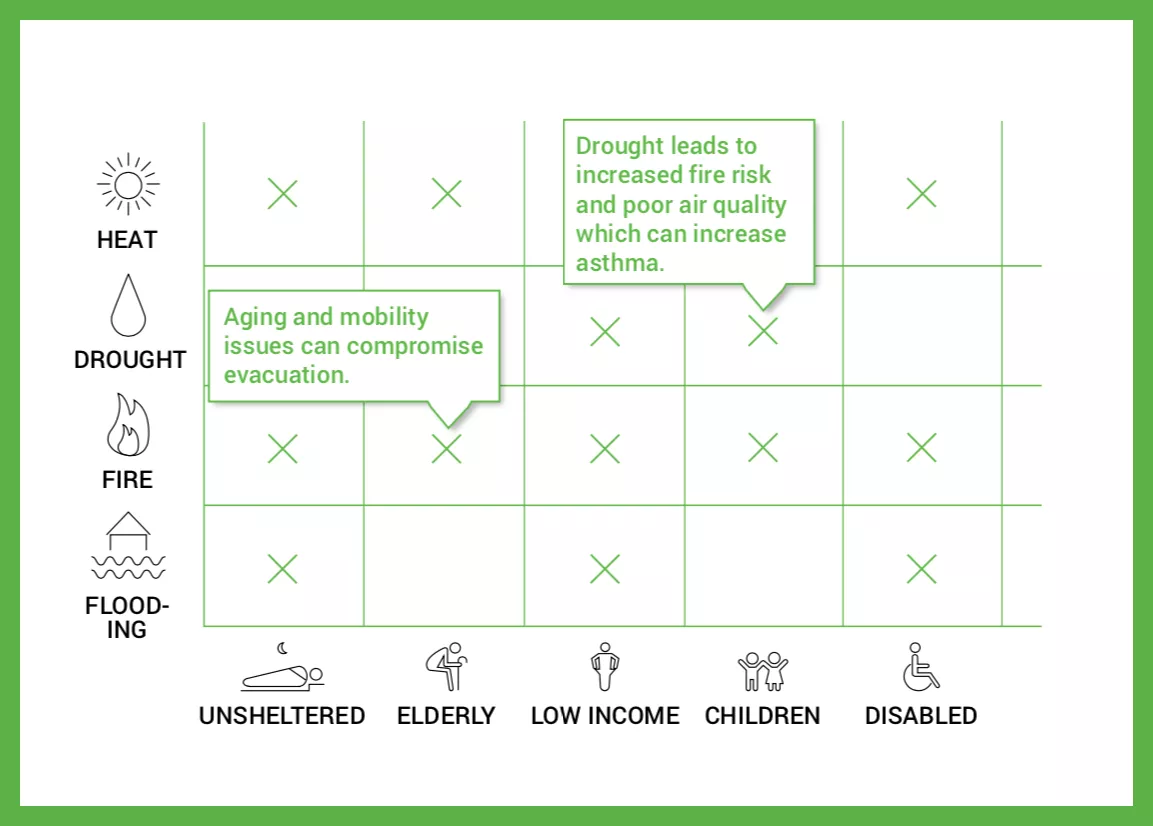As a C40 City, the City of Los Angeles is very engaged with Climate Change efforts. The Climate Change case study aligns to SDG Goal 13: Climate Action. While Goal 13 directly addresses climate change, this is a cross-cutting issue that encompasses all of the SDGs. Thus, leveraging climate change as a case study allows the intersectionalities between the SDG goals to be studied and recommendations to be made across all of the goals.
The case study was completed in partnership with students from the UCLA Luskin School of Public Affairs and Thunderbird School of Global Management at Arizona State University, with support from Caltech and NASA.
SDG 13: Climate Action proposes targets that take urgent action to combat climate change and its impacts. As a city, Los Angeles has been at the forefront of efforts to combat climate change through our City of L.A.’s Green New Deal (City of L.A.’s Sustainability pLAn) and Resilient L.A., as well as in partnership with cities around the country (Climate Mayors) and around the world (C40, 100 Resilient Cities).
Given the number of targets and commitments already in place, the summer student cohort sought to produce a series of deliverables demonstrating how the SDG framework could inform implementation of the City’s sustainability and resiliency initiatives. They first aligned the three plans, seeking to understand both gaps and overlaps; they then looked at best practices across other cities, and finally, they developed recommendations based on the first two deliverables to mitigate the impact of various climate change-related threats on different vulnerable populations within the City.
The best practices from other Cities and the intersectionality of the SDGs offer the chance to consider how the impact of climate threats may be felt differently across our community, and likewise, how to tailor and prioritize mitigation and adaptation planning to account for those different populations.
Best Practices
![]()
SAN FRANCISCO
UHI (Urban Heat Island) index for a neighborhood level
Can use to tailor mitigation by neighborhoods in LA.
![]()
NEW YORK CITY
Coordinated effort by the city to mitigate climate change
LA could showcase each department’s commitments and progress.
![]()
BOSTON
Projections of economic losses due to climate events
Use the cost of inaction to prioritize climate resilience initiatives.
![]()
COPENHAGEN
Feasibility analysis determining the strength of goals
Assess probability and severity when prioritizing adaptation plans.
Climate Change Threats and Vulnerable Populations
Best practices and the intersectionality of the SDGs point to considering the varied impact of climate threats, how they may be felt differently across our community, and likewise, how to tailor mitigation and adaptation planning to account for the needs of our most vulnerable.

The four climate change threats we identified to be most relevant to the City of Los Angeles are heat, drought, fire, and sea-level rise and flooding. And the five most vulnerable populations that we identified were the unsheltered, elderly, low-income, children and those with disabilities.
Heat
- Creation of a neighborhood UHI index in LA to prioritize adaptation and mitigation efforts
- Using a tree canopy analysis tool to strategically target tree planting locations
- Improving heat-health alert warning systems through SMS and phone call alerts
- Incorporate green roof research and implementation into Sustainability pLAn
- Expansion of Cooling Centers in disadvantaged communities that lack access to green spaces
- Increasing community awareness in most vulnerable communities through accessible and multilingual workshops
Drought
- Restore the tree canopy to retain excess rainwater and releasing water during droughts
- Provide drought education to increase awareness
- Encourage community participation in drought-related initiatives and strategies
- Track water trends within the city in order to increase transparency
- Have the city work with local water agencies to adopt drought-responsive pricing structures
Fire
- Expand access to wifi in public spaces to maximize WIFIRE in order to provide information to vulnerable communities that do not have regular access to internet services
- Provide masks to unsheltered populations after a wildfire event
Sea Level Rise and Flooding
- Restore coastal ecosystems (such as wetland and dunes)
- Install dry reservoirs and water retention systems in areas expected to flood
- Managed retreat in areas most vulnerable to flooding
- Ensure that industries, especially industries that handle toxic materials and chemical, are prepared for flooding
Additional Climate Change Recommendations
- Creation of a Green Jobs energy jobs training program designed to specifically engage underrepresented groups
- Further emphasize and promote renewable energies in order to attract solar and wind companies
- Partnerships with local universities, private sector, and the public sector to attract the underrepresented into Green Jobs pathways